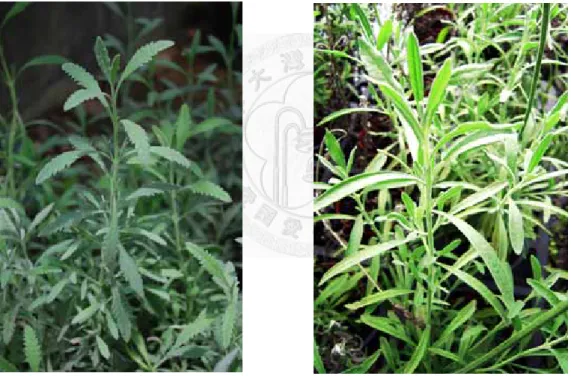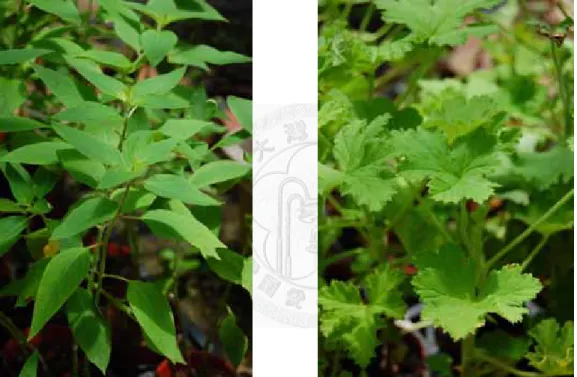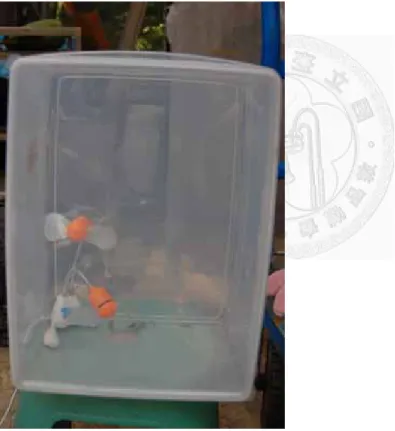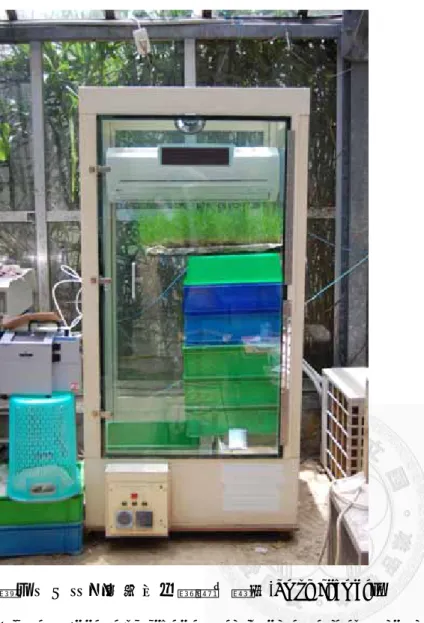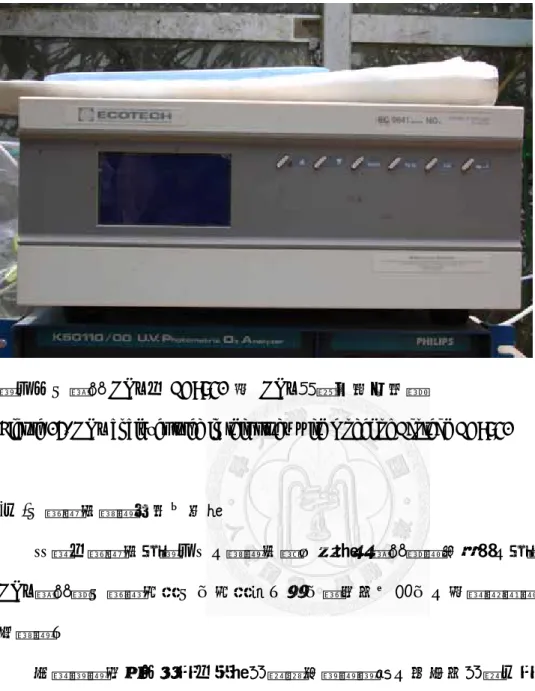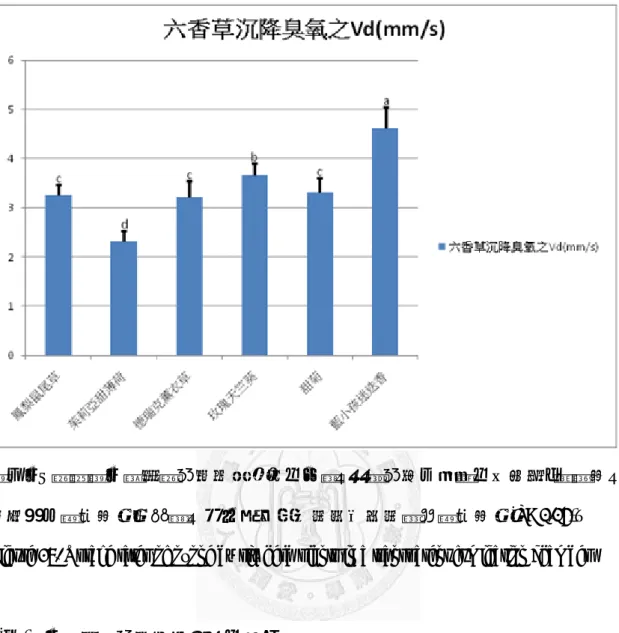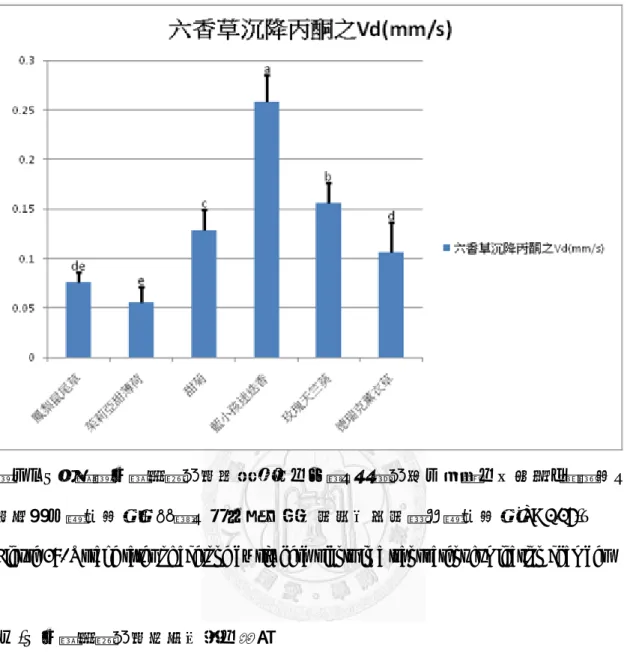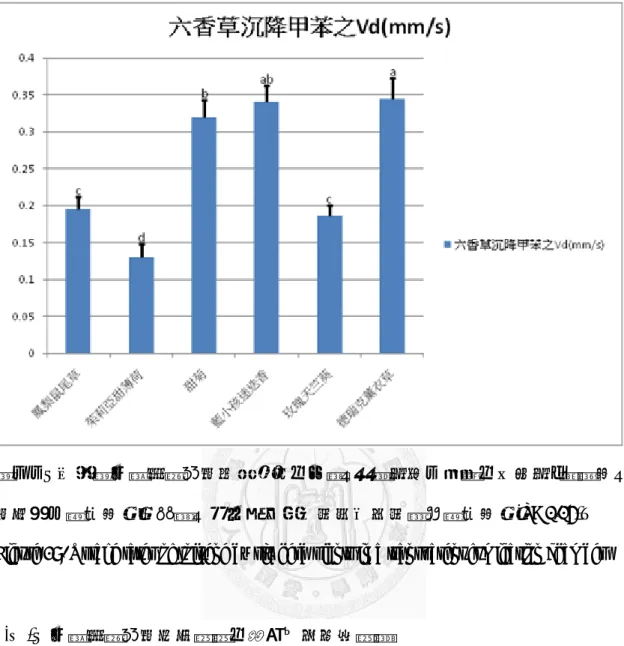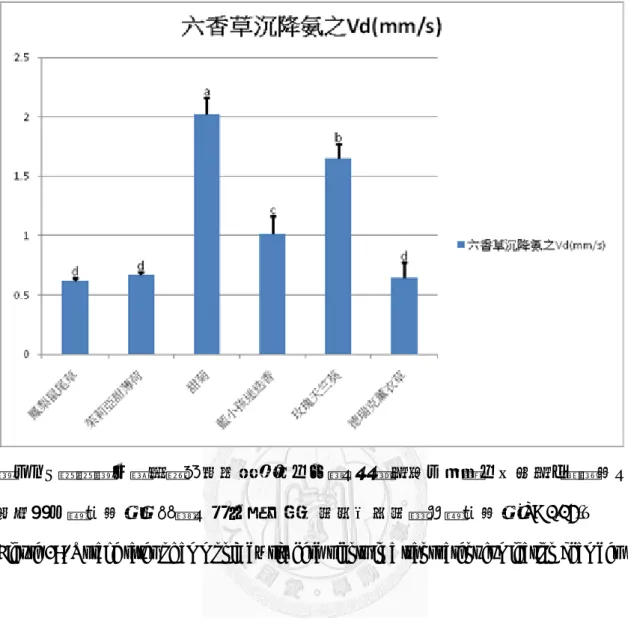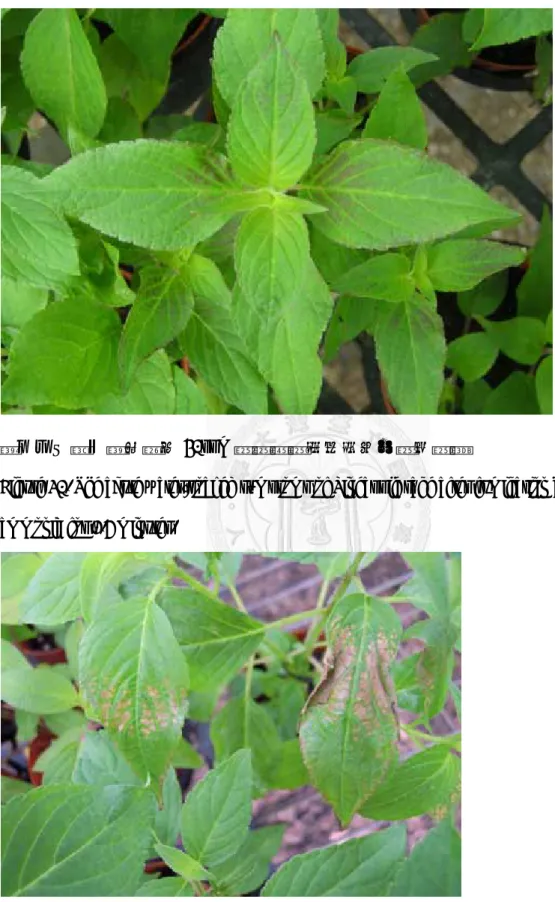1
國立台灣大學植物病理與微生物學研究所 碩士論文
Department of Plant Pathology and Microbiology College of Bioresources and Agriculture
National Taiwan University Master Thesis
香草植物淨污能力及與光化反應相關之研究 The absorption of air pollutants by herbs and their
association with photochemical reaction
研究生:張元 Yuan Jhang
指導教授:孫岩章博士 Adviser: Dr. En-Jang Sun
中華民國一百年七月
July,2011
i
ii
致謝
兩年的研究生生活眨眼即逝,眼前彷彿我才剛踏入這個實驗室,怎麼現在就 要離開了。非常感謝孫老師在這兩年的悉心教導和照顧,老師就像一位父親,讓 我這離家的遊子有爸爸在身邊的感覺,倍感溫馨。
謝謝口試委員王亞男老師、張育森老師及鄭福田老師願意在百忙之中抽空為 我們口試,提供我們意見而使得論文更加完善。
當然,我可愛的實驗室同學們:思羽、健新、哲維、均岳、鳳書、洹瑜、勝 志、友倫、凱婷、雅博,想著跟大家一起吃喝玩樂、趕實驗、拼論文、抱佛腳的 種種,就覺得脫線的我一直有你們罩----真好!超愛你們的啦!
最後,感謝我親愛的家人,感謝老爸老媽不斷的提攜栽培和千叮萬囑,還有 老弟三不五時的電話關心都讓我備感窩心。
iii
中文摘要
本實驗目的在探討常見香草植物對於四種空氣污染物質淨化的能力,並研究 磁場方向對這些香草植物淨污能力的影響,以及探討香草所揮發出的香氣成分與 光化污染物中的臭氧之間的關聯性。
從花市買回試驗用的香草植物,經一段時間馴化後,利用 21 公升薰氣箱系統 做香草對於 100ppb 臭氧、300ppm 丙酮、30ppm 甲苯、30ppm 氨氣沉降的試驗;結 果顯示,藍小孩迷迭香對於臭氧、丙酮及甲苯皆有不錯的沉降能力,德瑞克薰衣 草對於甲苯也有相當的淨污功效,而甜菊對於氨氣、甲苯沉降的效果最好,但會 因其敏感性高,出現氨氣受害病徵,而使得淨污功效無法持久。經多種氣體吸收 之交叉比較,則以藍小孩迷迭香、甜菊、玫瑰天竺葵三種香草植物對上述四種氣 體皆有不錯的吸收能力,故值得在辦公室及住家予以推薦及應用。
另外,以磁場強度約 1000mT 的磁鐵置入影響的磁場方向,經一段時間馴化後,
利用薰氣箱系統做香草對於 100ppb 臭氧、300ppm 丙酮、30ppm 甲苯、30ppm 氨氣 沉降的試驗;結果顯示,磁場方向對於香草植物淨污能力大致上無明顯影響,但 少數植物,如甜菊,在負極似有增進吸收氨之趨勢。
將七種香草在晴天情況下,置入 90 x 90 x 180 公分之透明煙霧室,並進行臭氧 及二氧化氮的監測,結果顯示七種中有五種香草可持續吸收沉降臭氧,其經 50 下 之拍打,會釋出精油並可嗅得,但並不會增加臭氧之濃度;另兩種即藍小孩迷迭 香則在拍打下可讓臭氧監測儀偵測到飆高之臭氧,而玫瑰天竺葵在拍打 50 下後,
更讓臭氧濃度飆升 6 倍以上,此些臭氧濃度飆升之原因目前仍未可知,即仍有待 進一步之研究。
由本研究香草植物淨污能力的結果顯示,不同植物對不同污染物有不同吸收 沉降能力,建議在實際應用時應依不同場合選擇適當的香草種植,以利吸收空氣 污染,而甜菊對氨氣表現出高度的敏感性,對於發展成為氨氣污染指標植物有相 當的潛能。另,如香草之精油或香氣真有助臭氧之生成,則可期望控制香草之受
iv
傷程度,使其只產生小量臭氧,進而達到利用室內栽培香草植株進行最天然的室 內消毒殺菌兼具淨化污染之雙重效果。
關鍵字:香草植物、臭氧、丙酮、甲苯、氨氣、磁場、精油、光化污染
v
Summary
The aim of this research is to investigate the ability of common herbs to purify four kinds of air pollutants, to study the effects of magnetic field direction on the capacity of herbs to purify air pollutants, and to explore the correlation between essential oils volatilized by herbs and ozone which is the main product of photochemical reaction.
Herbs plants were bought from the flower market, acclimatized for a period of time, and used for uptake measurements. A transparent fumigation chamber with size of 21L, is
designed to measure the uptake rate of these herbs against 100ppb ozone, 300ppm acetone, 30ppm toluene, and 30ppm ammonia. Results showed that Blue Boy rosemary has the greatest deposition velocity for absorbing ozone, acetone and toluene, Giant Lavender is also good at absorbing the pollution of toluene, and stevia has the best ability to absorb ammonia.
However stevia is highly sensitive to ammonia. It will suffer and show injury symptoms, making it difficult to uptake ammonia for a long time. After a collective screening and comparison, Blue Boy rosemary, stevia, and Rose geranium are recommended as an adequate plant set for uptaking all four toxic gases in office and house.
Round magnet with diameter of 1.2 cm, and magnetic field of 1000mT, were used for studying the effects of magnetic field direction on the capacity of herbs to purify four kinds of air pollutants. The transparent fumigation chamber is also used to measure the uptake rate of ozone at 100ppb, acetone at 300ppm, toluene at 30ppm, and ammonia at 30ppm,
respectively. Results showed that generally the magnetic field direction can not significantly affect the capacity of herbs to purify four kinds of air pollutants. Only stevia showed higher uptake to ammonia at negative magnetic field and non magnetic field.
A transparent smog chamber with size of 90 x 90 x 180Cm was designed and setup for studying the photochemical reaction related with herb essential oils. Out of seven herb species, five herbs simply play the role as air-cleaner as they can absorb ozone and nitrogen
vi
dioxide constantly in the smog chamber. However, when Blue Boy rosemary and Rose geranium were beaten for 50 times by hand to make the essential oil release, the ozone concentration bump up dramatically in the chamber. The reason is still unknown and need more investigation in the future.
As different plants exhibited different capability to purify different air pollutants, we recommend people to choose the appropriate herbs at different location, so that they can clean the air more efficiently. Since stevia showed a high degree of sensitivity to ammonia, it probably can be used as an indicator plant for ammonia pollution. When the herbs were proven to induced photochemical reaction and raise the ozone concentration, we may expect to partially harm the herbs, so that the ozone concentration is only beneficial for disinfecting.
Then the herbs can play both the roles of air cleaner and disinfectant in indoor areas.
Keywords: Herbs, ozone, acetone, toluene, ammonia, magnetic field, essential oil, photochemical pollution
vii
目 錄
口試委員會審定書...i
致謝...ii
中文摘要...iii
英文摘要...v
第一章 前言...1
第二章 前人研究...2
第一節、臭氧之特性...2
第二節、丙酮之特性...3
第三節、甲苯之特性...3
第四節、氨氣之特性...4
第五節、植物淨化空氣污染...4
第六節、磁場與植物...5
第七節、生物源揮發性有機物及光化反應...5
第三章 材料與方法...7
第一節、常見香草植物吸收污染能力之試驗...7
(一)、試驗香草植物...7
(二)、試驗香草植物之栽培及管理...10
(三)、香草植物吸收臭氧之試驗...11
1.熏氣箱設備設計...11
2.產氣設備設計...12
3.監測設備...12
4. 測量方法、流程及計算...13
(四)、香草植物吸收丙酮之試驗...14
(五)、香草植物吸收甲苯之試驗...15
viii
(六)、香草植物吸收氨氣之試驗...15
第二節、不同磁場方向對植物吸收污染之影響...15
(一)、不同磁場方向對植物吸收臭氧之影響...15
(二)、不同磁場方向對植物吸收丙酮之影響...16
(三)、不同磁場方向對植物吸收甲苯之影響...16
(四)、不同磁場方向對植物吸收氨氣之影響...16
第三節、 香草植物香氣與臭氧之關係...16
(一)、煙霧反應室(Smog chamber)之設計...16
(二)、監測設備...17
(三)、煙霧室試驗方法及流程...18
第四章 結果...19
第一節、常見香草植物吸收污染能力之試驗...19
(一)、六種香草植物吸收臭氧之效率...19
(二)、六種香草植物吸收丙酮之效率...21
(三)、六種香草植物吸收甲苯之效率...23
(四)、六種香草植物吸收氨氣之效率及其受害病徵...25
第二節、不同磁場方向對植物吸收污染之影響...31
(一)、不同磁場方向對植物吸收臭氧之影響...31
(二)、不同磁場方向對植物吸收丙酮之影響...38
(三)、不同磁場方向對植物吸收甲苯之影響...46
(四)、不同磁場方向對植物吸收氨氣之影響...54
第三節、 香草植物香氣與臭氧之關係...62
(一)、異戊二烯及 NOx 在光化反應中之反應及影響...63
(二)、青紫蘇在光化煙霧室中之反應及影響...64
(三)、甜菊在光化煙霧室中之反應及影響...67
ix
(四)、鳳梨鼠尾草在光化煙霧室中之反應及影響...69
(五)、甜薰衣草在光化煙霧室中之反應及影響...71
(六)、茱莉亞甜薄荷在光化煙霧室中之反應及影響...73
(七)、藍小孩迷迭香在光化煙霧室中之反應及影響...75
(八)、玫瑰天竺葵在光化煙霧室中之反應及影響...77
第五章 討論...80
引用文獻...85
x
圖目錄
圖一、台灣地區 2001 年至 2010 年間臭氧年平均濃度變化...3 Figure 1. The variation of annual means of ozone concentration in Taiwan from 2001 to 2010 圖二、本試驗用之藍小孩迷迭香...7 Figure 2. Blue Boy rosemary used in this study
圖三、本試驗用之甜菊...7 Figure 3. stevia used in this study
圖四、本試驗用之德瑞克薰衣草...8 Figure 4. Giant lavender used in this study
圖五、本試驗用之甜薰衣草...8 Figure 5. Sweet lavender used in this study
圖六、本試驗用之鳳梨鼠尾草...9 Figure 6. Pineapple sage used in this study
圖七、本試驗用之玫瑰天竺葵...9 Figure 7. Rose geranium used in this study
圖八、本試驗用之茱莉亞甜薄荷...10 Figure 8. Julia's Sweet Citrus mint used in this study
圖九、本試驗用之青紫蘇...10 Figure 9. shiso used in this study
圖十、供試香草植物吸收污染之透明熏氣箱...11 Figure 10. Transparent fumigation chamber used for gas uptake by herb plants
圖十一、臭氧產生機...12 Figure 11. Ozone generator used in this study
圖十二、監測臭氧濃度之 K50110/00 U.V. Photometric O3 Analyzer...12 Figure 12. U.V. photometric O3 analyzer used in this study with model of Phillips K50110/00
xi
圖十三、熏氣箱及氣體揮發產氣裝置,內有幫浦連接產氣瓶及熏氣箱...14 Figure 13. Fumigation chamber and gas generator using the constant evaporation apparatus and blowing pump to connect
圖十四、本研究所用之煙霧反應室(Smog chamber) ...17 Figure 14. The smog chamber used in this experiment with size of 90x90x180 Cm (l x w x h) 圖十五、監測 NOx 之 EC9841 型 NOx 氮氧化物分析儀...18 Figure 15. NOx analyzer used in this study with model of Ecotech EC9841
圖十六、臭氧對六種香草植物沉降速度之比較...21 Figure 16. Uptake rates of ozone by six herb plants in a transparent fumigation chamber 圖十七、丙酮對六種香草植物沉降速度之比較...23 Figure 17. Uptake rates of acetone by six herb plants in a transparent fumigation chamber 圖十八、甲苯對六種香草植物沉降速度之比較...25 Figure 18. Uptake rates of toluene by six herb plants in a transparent fumigation chamber 圖十九、氨氣對六種香草植物沉降速度之比較...27 Figure 19. Uptake rates of ammonia by six herb plants in a transparent fumigation chamber 圖二十、鳳梨鼠尾草受 30ppm 氨氣薰氣後的急性水浸狀病徵...28 Figure 20. The acute water-soaked symptoms of Pineapple sage after fumigation by 30ppm ammonia for 1.5 minutes.
圖二十一、鳳梨鼠尾草受 30ppm 氨氣薰氣後三日出現褐色塊斑及深褐色塊斑...28 Figure 21. The browning blotch symptoms of Pineapple sage after fumigated by 30ppm ammonia for 1.5 minutes after 3 days
圖二十二、鳳梨鼠尾草受 30ppm 氨氣薰氣後三日出現亮銅斑...29 Figure 22. The browning symptoms of Pineapple sage after fumigated by 30ppm ammonia for 1.5 minutes after 3 days
圖二十三、甜菊受 30ppm 氨氣薰氣後發生急性水浸狀病徵...29
xii
Figure 23. The acute water-soaked symptoms of stevia after fumigated by 30ppm ammonia for 1.5 minutes
圖二十四、甜菊以 30ppm 的氨氣濃度下熏氣約 3 分鐘後出現葉片變黑、葉捲曲之 情況。...30 Figure 24. The stevia leaves showed sever necrosis and curled after fumigation by 30ppm ammonia for 1.5 minutes after 3 minutes
圖二十五、鳳梨鼠尾草以 30ppm 的氨氣濃度下熏氣之後,葉片顏色變深和葉捲曲 的狀況。...30 Figure 25. The leaves of Pineapple sage showed sever necrosis and curled after fumigation by 30ppm ammonia for 1.5 minutes after one day
圖二十六、鳳梨鼠尾草盆底擺放正負極磁場及無磁場對臭氧氣體吸收沉降速度之 比較...33 Figure 26. Uptake rates of ozone by Pineapple sage growing in 3-inch pots each with one magnet in the bottom with S or N magnetic field toward the plant, an compared with control without any magnet
圖二十七、茱莉亞甜薄荷盆底擺放正負極磁場及無磁場對臭氧氣體吸收沉降速度 之比較...34 Figure 27. Uptake rates of ozone by Julia's Sweet citrus mint growing in 3-inch pots each with one magnet in the bottom with S or N magnetic field toward the plant, an compared with control without any magnet
圖二十八、德瑞克薰衣草盆底擺放正負極磁場及無磁場對臭氧氣體吸收沉降速度 之比較...35 Figure 28. Uptake rates of ozone by Giant lavender growing in 3-inch pots each with one magnet in the bottom with S or N magnetic field toward the plant, an compared with control without any magnet
xiii
圖二十九、玫瑰天竺葵盆底擺放正負極磁場及無磁場對臭氧氣體吸收沉降速度之 比較...36 Figure 29. Uptake rates of ozone by Rose geranium growing in 3-inch pots each with one magnet in the bottom with S or N magnetic field toward the plant, an compared with control without any magnet
圖三十、甜菊盆底擺放正負極磁場及無磁場對臭氧氣體吸收沉降速度之比
較...37 Figure 30. Uptake rates of ozone by stevia growing in 3-inch pots each with one magnet in the bottom with S or N magnetic field toward the plant, an compared with control without any magnet
圖三十一、藍小孩迷迭香盆底擺放正負極磁場及無磁場對臭氧氣體吸收沉降速度 之比較...38 Figure 31. Uptake rates of ozone by Blue Boy rosemary growing in 3-inch pots each with one magnet in the bottom with S or N magnetic field toward the plant, an compared with control without any magnet
圖三十二、鳳梨鼠尾草盆底擺放正負極磁場及無磁場對丙酮氣體吸收沉降速度之 比較...41 Figure 32. Uptake rates of acetone by Pineapple sage growing in 3-inch pots each with one magnet in the bottom with S or N magnetic field toward the plant, an compared with control without any magnet
圖三十三、茱莉亞甜薄荷盆底擺放正負極磁場及無磁場對丙酮氣體吸收沉降速度 之比較...42 Figure 33. Uptake rates of acetone by Julia's Sweet citrus mint growing in 3-inch pots each with one magnet in the bottom with S or N magnetic field toward the plant, an compared with control without any magnet
xiv
圖三十四、甜菊盆底擺放正負極磁場及無磁場對丙酮氣體吸收沉降速度之比 較...43 Figure 34. Uptake rates of acetone by stevia growing in 3-inch pots each with one magnet in the bottom with S or N magnetic field toward the plant, an compared with control without any magnet
圖三十五、藍小孩迷迭香盆底擺放正負極磁場及無磁場對丙酮氣體吸收沉降速度 之比較...44 Figure 35. Uptake rates of acetone by Blue Boy rosemary growing in 3-inch pots each with one magnet in the bottom with S or N magnetic field toward the plant, an compared with control without any magnet
圖三十六、玫瑰天竺葵盆底擺放正負極磁場及無磁場對丙酮氣體吸收沉降速度之 比較...45 Figure 36. Uptake rates of acetone by Rose geranium growing in 3-inch pots each with one magnet in the bottom with S or N magnetic field toward the plant, an compared with control without any magnet
圖三十七、德瑞克薰衣草盆底擺放正負極磁場及無磁場對丙酮氣體吸收沉降速度 之比較...46 Figure 37. Uptake rates of acetone by Giant lavender growing in 3-inch pots each with one magnet in the bottom with S or N magnetic field toward the plant, an compared with control without any magnet
圖三十八、鳳梨鼠尾草盆底擺放正負極磁場及無磁場對甲苯氣體吸收沉降速度之 比較...49 Figure 38. Uptake rates of toluene by Pineapple sage growing in 3-inch pots each with one magnet in the bottom with S or N magnetic field toward the plant, an compared with control without any magnet
xv
圖三十九、茱莉亞甜薄荷盆底擺放正負極磁場及無磁場對甲苯氣體吸收沉降速度 之比較...50 Figure 39. Uptake rates of toluene by Julia's Sweet citrus mint growing in 3-inch pots each with one magnet in the bottom with S or N magnetic field toward the plant, an compared with control without any magnet
圖四十、玫瑰天竺葵盆底擺放正負極磁場及無磁場對甲苯氣體吸收沉降速度之比 較...51 Figure 40. Uptake rates of toluene by Rose geranium growing in 3-inch pots each with one magnet in the bottom with S or N magnetic field toward the plant, an compared with control without any magnet
圖四十一、德瑞克薰衣草盆底擺放正負極磁場及無磁場對甲苯氣體吸收沉降速度 之比較...52 Figure 41. Uptake rates of toluene by Giant lavender growing in 3-inch pots each with one magnet in the bottom with S or N magnetic field toward the plant, an compared with control without any magnet
圖四十二、甜菊盆底擺放正負極磁場及無磁場對甲苯氣體吸收沉降速度之比較....53 Figure 42. Uptake rates of toluene by stevia growing in 3-inch pots each with one magnet in the bottom with S or N magnetic field toward the plant, an compared with control without any magnet
圖四十三、藍小孩迷迭香盆底擺放正負極磁場及無磁場對甲苯氣體吸收沉降速度 之比較...54 Figure 43. Uptake rates of toluene by Blue Boy rosemary growing in 3-inch pots each with one magnet in the bottom with S or N magnetic field toward the plant, an compared with control without any magnet
圖四十四、鳳梨鼠尾草盆底擺放正負極磁場及無磁場對氨氣氣體吸收沉降速度之
xvi
比較...57 Figure 44. Uptake rates of ammonia by Pineapple sage growing in 3-inch pots each with one magnet in the bottom with S or N magnetic field toward the plant, an compared with control without any magnet
圖四十五、茱莉亞甜薄荷盆底擺放正負極磁場及無磁場對氨氣氣體吸收沉降速度 之比較...58 Figure 45. Uptake rates of ammonia by Julia's Sweet citrus mint growing in 3-inch pots each with one magnet in the bottom with S or N magnetic field toward the plant, an compared with control without any magnet
圖四十六、甜菊盆底擺放正負極磁場及無磁場對氨氣氣體吸收沉降速度之比較... 59 Figure 46. Uptake rates of ammonia by stevia growing in 3-inch pots each with one magnet in the bottom with S or N magnetic field toward the plant, an compared with control without any magnet
圖四十七、藍小孩迷迭香盆底擺放正負極磁場及無磁場對氨氣氣體吸收沉降速度 之比較...60 Figure 47. Uptake rates of ammonia by Blue Boy rosemary growing in 3-inch pots each with one magnet in the bottom with S or N magnetic field toward the plant, an compared with control without any magnet
圖四十八、玫瑰天竺葵盆底擺放正負極磁場及無磁場對氨氣氣體吸收沉降速度之 比較...61 Figure 48. Uptake rates of ammonia by Rose geranium growing in 3-inch pots each with one magnet in the bottom with S or N magnetic field toward the plant, an compared with control without any magnet
圖四十九、德瑞克薰衣草盆底擺放正負極磁場及無磁場對氨氣氣體吸收沉降速度 之比較...62
xvii
Figure 49. Uptake rates of ammonia by Giant lavender growing in 3-inch pots each with one magnet in the bottom with S or N magnetic field toward the plant, an compared with control without any magnet
圖五十、在光化煙霧室中加入 1ml 之異戊二烯後溫度及相對濕度之變化示意圖.... 63 Figure 50. The change of temperature and relative humisity after adding 1ml isoprene into the smog chamber
圖五十一、在光化煙霧室中加入 1ml 之異戊二烯後臭氧及二氧化氮之濃度變化及 與空箱濃度變化之比較...64 Figure 51. The concentration change of O3 and NO2 after adding 1ml isoprene into the smog chamber
圖五十二、在光化煙霧室中放入三盆青紫蘇後溫度及相對濕度之變化示意圖...65 Figure 52. The change of temperature and relative humisity after placing 3 pots of shiso into the smog chamber
圖五十三、在光化煙霧室中放置三盆青紫蘇後臭氧及二氧化氮之濃度變化及與空 箱濃度變化之比較...66 Figure 53. The concentration change of O3 and NO2 after placing 3 pots of shiso into the smog chamber, as compared with blank control in empty chamber
圖五十四、在光化煙霧室中放置三盆青紫蘇並拍打共 50 下後臭氧及二氧化氮之濃 度變化及與空箱濃度變化之比較...67 Figure 54. The concentration change of O3 and NO2 after placing 3 pots of shiso into the smog chamber and beaten by hand for 50 times, as compared with blank control in empty chamber
圖五十五、在光化煙霧室中放置三盆甜菊後臭氧及二氧化氮之濃度變化及與空箱 濃度變化之比較...68 Figure 55. The concentration change of O3 and NO2 after placing 3 pots of stevia into the
xviii
smog chamber, as compared with blank control in empty chamber
圖五十六、在光化煙霧室中放置三盆甜菊並拍打共 50 下後臭氧及二氧化氮之濃度 變化及與空箱濃度變化之比較...69 Figure 56. The concentration change of O3 and NO2 after placing 3 pots of beaten stevia into the smog chamber and beaten by hand for 50 times, as compared with blank control in empty chamber
圖五十七、在光化煙霧室中放置三盆鳳梨鼠尾草後臭氧及二氧化氮之濃度變化及 與空箱濃度變化之比較...70 Figure 57. The concentration change of O3 and NO2 after placing 3 pots of Pineapple sage into the smog chamber, as compared with blank control in empty chamber
圖五十八、在光化煙霧室中放置三盆鳳梨鼠尾草並拍打共 50 下後臭氧及二氧化氮 之濃度變化及與空箱濃度變化之比較...71 Figure 58. The concentration change of O3 and NO2 after placing 3 pots of beaten Pineapple sage into the smog chamber and beaten by hand for 50 times, as compared with blank control in empty chamber
圖五十九、在光化煙霧室中放置三盆甜薰衣草後臭氧及二氧化氮之濃度變化及與 空箱濃度變化之比較...72 Figure 59. The concentration change of O3 and NO2 after placing 3 pots of Sweet lavender into the smog chamber, as compared with blank control in empty chamber
圖六十、在光化煙霧室中放置三盆甜薰衣草並拍打共 50 下後臭氧及二氧化氮之濃 度變化及與空箱濃度變化之比較...73 Figure 60. The concentration change of O3 and NO2 after placing 3 pots of beaten Sweet lavender into the smog chamber and beaten by hand for 50 times, as compared with blank control in empty chamber
圖六十一、在光化煙霧室中放置三盆茱莉亞甜薄荷後臭氧及二氧化氮之濃度變化
xix
及與空箱濃度變化之比較...74 Figure 61. The concentration change of O3 and NO2 after placing 3 pots of Julia's Sweet citrus mint into the smog chamber, as compared with blank control in empty chamber 圖六十二、在光化煙霧室中放置三盆茱莉亞甜薄荷並拍打共 50 下後臭氧及二氧化 氮之濃度變化及與空箱濃度變化之比較...75 Figure 62. The concentration change of O3 and NO2 after placing 3 pots of beaten Julia's Sweet citrus mint into the smog chamber and beaten by hand for 50 times, as compared with blank control in empty chamber
圖六十三、在光化煙霧室中放置三盆藍小孩迷迭香後臭氧及二氧化氮之濃度變化 及與空箱濃度變化之比較...76 Figure 63. The concentration change of O3 and NO2 after placing 3 pots of Blue Boy
rosemary into the smog chamber, as compared with blank control in empty chamber
圖六十四、在光化煙霧室中放置三盆藍小孩迷迭香並拍打共 50 下後臭氧及二氧化 氮之濃度變化及與空箱濃度變化之比較...77 Figure 64. The concentration change of O3 and NO2 after placing 3 pots of beaten Blue Boy rosemary into the smog chamber and beaten by hand for 50 times, as compared with blank control in empty chamber
圖六十五、在光化煙霧室中放置三盆玫瑰天竺葵後臭氧及二氧化氮之濃度變化及 與空箱濃度變化之比較...78 Figure 65. The concentration change of O3 and NO2 after placing 3 pots of Rose geranium into the smog chamber, as compared with blank control in empty chamber
圖六十六、在光化煙霧室中放置三盆玫瑰天竺葵並拍打共 50 下後臭氧及二氧化氮 之濃度變化及與空箱濃度變化之比較...79 Figure 66. The concentration change of O3 and NO2 after placing 3 pots of beaten Rose geranium into the smog chamber and beaten by hand for 50 times, as compared with blank
xx
control in empty chamber
xxi
表目錄
表一、以熏氣箱測試臭氧對六種香草植物沉降速度之結果...20 Table 1. Uptake rates of ozone by six herb plants in a transparent fumigation chamber 表二、以熏氣箱測試丙酮對六種香草植物沉降速度之結果...22 Table 2. Uptake rates of acetone by six herb plants in a transparent fumigation chamber 表三、以熏氣箱測試甲苯對六種香草植物沉降速度之結果...24 Table 3. Uptake rates of toluene by six herb plants in a transparent fumigation chamber 表四、以熏氣箱測試氨氣對六種香草植物沉降速度之結果...26 Table 4. Uptake rates of ammonia by six herb plants in a transparent fumigation chamber 表五、在不同磁場方向下測試臭氧對六種香草植物沉降速度之結果...32 Table 5. Uptake rates of ozone by six herb plants growing in 3-inch pots each with one magnet in the bottom with S or N magnetic field toward the plant, as compared with blank control
表六、磁場影響下,以熏氣箱測試丙酮對六種香草植物沉降速度之結果...40 Table 6. Uptake rates of acetone by six herb plants growing in 3-inch pots each with one magnet in the bottom with S or N magnetic field toward the plant, as compared with blank control
表七、磁場影響下,以熏氣箱測試甲苯對六種香草植物沉降速度之結果...48 Table 7. Uptake rates of toluene by six herb plants growing in 3-inch pots each with one magnet in the bottom with S or N magnetic field toward the plant, as compared with blank control
表八、磁場影響下,以熏氣箱測試氨氣對六種香草植物沉降速度之結果...56 Table 8. Uptake rates of ammonia by six herb plants growing in 3-inch pots each with one magnet in the bottom with S or N magnetic field toward the plant, as compared with blank control
1
第一章 前言
隨著經濟成長,許多空氣污染問題跟著而來,從一開始的室外空氣品質到近 來引起關注的室內空氣品質,空氣污染的問題越顯被重視。
而近年來民眾亦逐漸注意環境的綠化,常種植或購買各種植物以美化生活環 境,其中香草植物是最熱門的植物種類。
綠色植物除了扮演生產者的角色、遮陰、降溫、調節微氣候、美化環境、愉 悅身心以外,尚有另一功效便為淨化環境污染,尤其是空氣中的各類污染物。(王,
1997;宋,1998;李,1997;陳、孫,1999;孫,1993;1999;2004;2005;2006)。
在醫學領域方面,有許多磁場對動物生長影響的研究,例如正負極磁場對動 物生理所造成之反應以及癌症的治療等(楊朝榮,2009);但磁場對植物影響之研究 卻不多。
又植物雖經證實具有淨化空氣污染的能力,但亦有研究指出某些植物排放之 揮發性有機物(Volatile organic compound, VOC)會成為空氣中臭氧的前驅物質 ( precursor),而香草植物的揮發性氣味是否亦扮演類似之角色尚未可知。
故本研究目的有三:首先將針對香草植物進行淨化空氣污染能力之測試,次 將探討磁場正負極對於香草植物淨污能力的影響,第三部分則將探討香草植物的 揮發性物質對光化反應及臭氧生成之影響。希望可以了解比較不同香草植物淨化 空氣污染能力之差異,釐清磁場對於香草植物生長及淨污能力的影響,以提供人 們選擇香草植栽時的重要參考,並增進人類的福祉和幸福的感覺。
2
第二章 前人研究 第一節、臭氧之特性
臭氧(Ozone)為無色或藍色具稻草味的氣體,隨著都市人車增加及工業之發展,
光化反應產生的臭氧亦逐年增加並成為評定空氣品質標準 PSI (Pollutants Standard Index)的指標之一,依據環保署資料可知,過去十年間,台灣地區臭氧濃度即有逐 漸升高的趨勢。(如圖一)
臭氧是性質活潑的氧化劑,某些研究顯示若人長時間暴露於高臭氧下,會造 成頭痛、疲倦、咳嗽等症狀,甚至引發氣喘。(White et al., 1994);另外,臭氧對植 物,包括農作物,亦有不良的影響(Heck et al., 1988; Sun, 1994a; 許宏等, 2007),1971 年台灣地區就有學者證實臭氧會造成菸草的氣候斑(Stree et al., 1971)。此外,臭氧 亦是溫室效應氣體,會助長地球的暖化及氣候的變遷。(Arblaster et al., 2011)
臭氧是二次污染物,並非直接由污染源排放,而是由氮氧化物(NOx)與揮發 性有機物(VOCs)經過複雜的光化學反應而來,為光化學污染的主成分之一,而 不同的揮發性有機物對臭氧生成的影響亦有所不同,之前的研究即顯示,在光化 污染較嚴重的地區,其 VOCs 主要有甲苯(Toluene)、異丁烯(iso-Butene)、乙烷(Ethane)、
丙烷(Propane)、乙烯(Ethene)、異戊二烯(iso-prene)、乙炔(Acetylene)、正丁烷(n-Butane) 等 (王&張等,2003) ,另亦有文獻指出,植物會排放出生物源揮發性有機物質。
3
圖一、台灣地區 2001 年至 2010 年間臭氧年平均濃度變化(參考行政院環保署資料) Figure 1. The variation of annual means of ozone concentration in Taiwan from 2001 to 2010
第二節、丙酮之特性
丙酮(Acetone)在常溫下為無色透明液體,有特殊甜味,低濃度下對人體沒有急 性之危害效應,在大氣環境中的丙酮不會蓄積,即在有氧或無氧狀況下均會迅速 分解。人體新陳代謝下,身體內小量丙酮會氧化成二氧化碳經呼吸及尿液排出。
但人體長期接觸丙酮可能造成皮膚脫脂和發炎。(物質安全資料表)。
在日常生活周遭,會產生丙酮的污染源有:化妝品、去光水、修正液、未印 刷紙張、生物排泄物等( Wolverton, 1997),而目前常用以除去丙酮的方法有吸附法、
光觸媒法(彭,2008)及植物吸收( Wolverton, 1997)等。
第三節、甲苯之特性
甲苯(Toluene)常溫下是高揮發性無色澄清液體,其氣味具芳香族特性。甲苯為 重要的工業原料,常用在噴漆、塗料、橡膠、皮革、印刷、絕緣材料、膠黏劑、
油漆等,因此甲苯是室內空氣污染的主要氣體之一(周亶等,2010;劉洋等,2006),
24 25 26 27 28 29 30 31 32
臭氧濃度
臭氧濃度 ppb
4
人體長期處於高甲苯環境中,會引起皮膚炎、噁心、頭痛、神經衰弱等慢性中毒 的症狀及腦、肝和腎的損害,亦有致癌的風險 (物質安全資料表) 。
目前移除甲苯常用的方法有吸附法(沈君洋,2009)、吸收洗滌法、冷凝法、變 壓吸附法(周亶等,2010)、光催化(劉洋等,2006)、微生物法(鄭連英等,2002)、植 物沉降(周亶等,2010;Wolverton, 1997)等方法。
第四節、氨氣之特性
氨氣(Ammonia)常溫下為無色、強刺激性、具腐蝕性的氣體,會刺激人體呼吸 道及眼睛等。人類處於 20~25ppm 的氨氣中會開始感覺刺激及不適(物質安全資料 表)。而日常生活中,會產生氨氣的污染源有:影印機、曬圖機、電子照像列印機、
微縮膠片製作機、生物排泄物及清潔劑等。( Wolverton, 1997)
第五節、植物淨化空氣污染
植物除了在自然界中扮演著生產者的角色,供給食物來源外,亦具有綠美化 環境、提供日用品原料、調節氣候、減少噪音、防風定砂、涵養水源、提供野生 動物棲息環境、吸收污染等功能。故在受污染地區利用適合的綠色植物來沉降污 染是一種實用的技術(王,1997;宋,1998;李,1997;陳、孫,1999;孫,1993;
1999;2004;2005;2006;鄭、孫,1999)。
國內外已有學者研究植物淨化各種污染的能力,如 Hill (1971)曾利用苜蓿及燕 麥進行對空氣污染沉降的調查研究,發現植物對於氟化氫(HF)、二氧化硫(SO2)、氯 氣(Cl2)、二氧化氮(NO2)、臭氧(O3)(康、孫,1999)、PAN、一氧化氮(NO)、一氧化碳 (CO)皆有沉降能力。而後其他學者已陸續證實植物有移除甲醛(HCHO)(陳,2006;
孫,2007)、二甲苯(C8H10)及甲苯(C7H8) (周等,2010;Cornejo et al., 1999; Kempeneer et al., 2004; Yoo et al., 2006)、苯(C6H6)( 孫,2007;楊,2007;Cornejo et al., 1999; Yoo et al., 2006)、三氯乙烯(C2HCl3)、氨(NH3)(Hutchinson et al., 1972; Porter et al., 1972; Van
5
Hove et al., 1989; Van Hove, et al., 1990; Whitehead and Lockyer, 1987; Ana et al., 2006;
Rogers et al., 1980; Massad et al., 2010)、酒精(C2H5OH)、丙酮(CO(CH3)2) ( Wolverton, 1997) 等功效。
而影響植物吸收氣體的因素很多,研究指出,主要因子有光強度( 呂,1997;
Hill, 1971; Thomas & Hill, 1935)、溫度(Thomas& Hill, 1935; Van Hove, et al., 1990)、濕 度(Mansfield, 1976)、土壤水分含量(Mansfield, 1976)、污染物濃度(Mansfield, 1976)、
擴散阻力(Mansfield, 1976)、植物生理狀況(Mansfield, 1976)、植物種類(Bruce, 1974;
Mansfield, 1976)、年齡(Mansfield, 1976)、營養(Mansfield, 1976)、葉表型態( Bennett, J.H. ; Hill, A.C. ; Gates, D.M.,1973 )、植株健康( Bennett ; Hill )等。
第六節、磁場與植物
生物磁學(biomagnetism)是研究磁場與生物間關係和影響的一門科學,像是如 經過學者長期的觀測和試驗,發現鳥類的導航與磁場有關(Rafael, 2011),而一些細 菌在水中沿磁場方向生長表現出向磁性(Franck, 2010)。而近年來生物磁學廣泛應用 於生物工程、醫學、環境保護、農業等方面,例如:人工心臟的電磁幫浦、在病 人患處或經穴施加適當強度的恆定磁場或交變磁場可治療一些疾病,稱為磁場療 法或簡稱磁療(林,2009),2009 文獻指出低頻磁場可引發肝癌細胞的自體吞噬作用 (autophagy)(2009,楊)。
而植物的生物磁學已有一些研究成果,如利用適當磁場強度處理植物種子可 提高植物幼苗抗寒害的能力(楊業玲、李光林,1998 )、增加黃瓜種子的亢旱能力(等,
2008)、增加種子的萌發率及提高其產量(包&雲,2010;Namba et al., 1995; Amaya et al., 1996; Namba, 1996; Namba et al., 1998; Torres et al., 1999; Maria et al., 2000)及增加 草莓產量(Ahmet, 2003)。
第七節、生物源揮發性有機物及光化反應
6
有學者指出,植物行光合作用之同時會排放出生物源揮發性有機物(Biogenic volatile organic compound, BVOC)( 葉,1995;Karlik et al., 2001; Simpson & McPherson, 2011; Chang et al., 2009; Niinemets et al., 2010),包括異戊二烯(isoprene)、單帖類 (monoterpene)、半帖類(sesquiterpene)等,其中以異戊二烯為大宗。因其性質活潑,
文獻指出這些生物源揮發性有機物亦會參與光化反應而產生臭氧。(孫,2004;彭,
2006;彭等,2008;彭等,2008;Castell1et al., 2008;Cheng and Sun, 2008)。
7
第三章 材料與方法 第一節、常見香草植物吸收污染能力之試驗
(一)、試驗香草植物
本項試驗共選擇八種常見香草植物做為試驗對象,分包括:藍小孩迷迭香、
甜菊、德瑞克薰衣草、甜薰衣草、鳳梨鼠尾草、玫瑰天竺葵、茱莉亞甜薄荷、青 紫蘇;其中青紫蘇、甜薰衣草二種只用於煙霧室(Somg Chamber)之試驗。簡介各種 植物如下:
1.藍小孩迷迭香 (Blue Boy Rosemary);如圖二,學名為Rosmarinus officinalis
唇形花科,為常綠性灌木,喜歡溫暖乾燥或排水良好的向陽地,葉短且細小,呈對生,嫩 枝呈白色,花紫色,可用於香料、烹調,有改善失眠及頭痛症狀之效,有助於提神醒腦。
圖二、本試驗用之藍小孩迷迭香 圖三、本試驗用之甜菊 Figure 2. Blue Boy rosemary used in this study Figure 3. stevia used in this study
8
2.甜菊 (Stevia) ;如圖三,學名為Stevia rebaudiana
菊科,雖是一年生草本植物,但在台灣可多年生栽培,用於替代糖做為調味,常用於減肥 及糖尿病患者,其甜度為蔗糖的 300 倍,而熱量是蔗糖的 1/90。
3.德瑞克薰衣草 (Giant Lavender);如圖四,學名為Lavandula x allardii
脣形花科的薰衣草類,又稱阿拉第薰衣草、大甜薰衣草、德克斯特薰衣草,為常綠灌木,
喜歡溫熱且陽光充足排水良好的山坡地,葉片較寬且厚,葉緣呈鋸齒狀,植株強壯耐旱,
整株呈現灰綠色。應用廣泛,可用於烹飪、香料等,具有驅蟲抗菌的效用。
圖四、本試驗用之德瑞克薰衣草 圖五、本試驗用之甜薰衣草
Figure 4. Giant lavender used in this study Figure 5. Sweet lavender used in this study
4.甜薰衣草 (Sweet Lavender) ;如圖五,學名為
Lavendula x heterophylla
脣形花科薰衣草類,又稱甜蜜薰衣草,是雜交種,同時具有狹葉薰衣草的芳香及 齒葉薰衣草的耐熱及耐濕特性,原產地在地中海地區,性喜溫熱、向陽的山坡地,
屬小型灌木。可用於甜點、泡茶、驅蟲、抗菌、沐浴、藥用、精油、護膚、護髮
9
等用途。
5.鳳梨鼠尾草 (Pineapple Sage) ;如圖六,學名為
Salvia elegans
唇形花科之鼠尾草類,又稱雅美鼠尾草,為多年生草本植物(亞灌木),喜歡溫暖潮濕的氣 候和肥沃的土壤,葉如水滴形狀,對生,顏色翠綠,頂生紅色穗狀花序,植株有鳳梨氣味。
可用於烹飪、香料、觀賞或煙薰除臭等。
圖六、本試驗用之鳳梨鼠尾草 圖七、本試驗用之玫瑰天竺葵
Figure 6. Pineapple sage used in this study Figure 7. Rose geranium used in this study
6.玫瑰天竺葵 (Rose Geranium) ;如圖七,學名為
Pelargonium x asperum
牻牛兒苗科天竺葵屬,為多年生草本,喜歡溫暖乾燥的向陽地,植株耐旱不耐濕,
要避免積水,莖肥厚多汁,葉互生,呈掌狀或近圓形的淺裂狀,表面被覆細密絨 毛,花粉紅色。
10
7.茱莉亞甜薄荷 (Julia's Sweet Citrus Mint);如圖八,學名為
Mentha sp. 'Julia's Sweet Citrus'
唇形科,為多年生草本植物,葉子呈翠綠色,莖上長有細毛,帶有甜甜的氣味。
圖八、本試驗用之茱莉亞甜薄荷 圖九、本試驗用之青紫蘇 Figure 8. Julia's Sweet Citrus mint used in this study Figure 9. shiso used in this study
8.青紫蘇(shiso) ;如圖九,學名為
Perilla frutescens
脣形花科,為多年生草本植物,性喜溫熱地區,葉呈綠色,與紫蘇之紫色不同,
可用於烹飪。
(二)、試驗香草植物之栽培及管理
各香草皆自花市買回,尺寸為三吋盆或五吋盆,其供磁場影響試驗者為使用 三吋盆之植栽,每種香草各分為三組,分別置入正極磁場、負極磁場及不置入磁 場三組。保持適當濕度,定期施肥,馴化四個禮拜後開始進行試驗。
11
而使用於香草吸收污染之測試者,亦使用三吋盆之植栽。唯使用於煙霧室之 光化反應測試者改用較大的五吋盆且枝葉茂密的植栽進行試驗。
(三)、香草植物吸收臭氧之試驗 1.熏氣箱之設備及設計
有關香草對臭氧之吸收,使用之熏氣箱 PP 材質,長寬高各為 42.3 公分、31 公分、20.4 公分,體積 21 公升的密封箱,如圖十,其內部加裝風扇以利於氣體之 均勻混合,並於兩測鑽孔分別連接監測設備和產氣設備。
圖十、供試香草植物吸收污染之透明熏氣箱
Figure 10. Transparent fumigation chamber used for gas uptake by herb plants
12
2.產氣設備
圖十一、臭氧產生機 Figure 11. Ozone generator used in this study
臭氧的產氣為直接利用臭氧產生機(圖十一),利用一般空氣經高壓放電以產生 臭氧,再以管線直接導入熏氣箱內進行試驗。
3.監測設備
臭氧的檢測為利用 Philips 公司出產的 K50110/00 U.V. Photometric O3
Analyzer(圖十二),可供連續監測,其原理為利用臭氧對波長 254nm 紫外光有最大 吸收峰,測定此波長下紫外光通過臭氧的衰減來監測臭氧之濃度。
圖十二、監測臭氧濃度之 K50110/00 U.V. Photometric O3 Analyzer
Figure 12. U.V. photometric O3 analyzer used in this study with model of Phillips K50110/00
13
4. 測量方法、流程及計算
香草植栽在測試前,為避免土壤介質之吸收及干擾,皆採用 PP 材質的塑膠模 先將植物花盆和介質完全包覆,只留植物地上枝葉部於塑膠膜外,將包好的植株 立即置入熏氣箱,熏氣箱兩側分別接上監測儀及產氣設備,即通入待測氣體至一 定量,即移除產氣瓶與熏氣箱間的連接,並將熏氣箱密封,開始監測記錄待測氣 體之濃度,每十秒記錄一次,共連續監測記錄 10 個數據。
另外,為測定待測氣體對箱體之沉降,於放入植株測試之前後,皆以空的熏 氣箱進行空箱氣體沉降的量測,以取得空箱變化之背景值。
本項植物對污染之吸收,皆根據質量不滅的原理,於植株置入熏氣箱後連續 監測其熏氣初始濃度及後續濃度的變化,求取濃度差,並扣除空箱的濃度差,結 果即為植物吸收沉降之質量,再將所得濃度差、受測植株的總葉面積、熏氣箱體 積和熏氣時間,併入下列公式計算,即可以算出沉降速度 ( Vd, deposition
velocity ):
Vd = { [ (C - C’)/C] x L - [ (C0 - C0’)/C0 ] x L0 } x 1/A x 1/T
C0’ :空箱熏氣後濃度(ppm 或 ppb) C0 :空箱熏氣初始濃度(ppm 或 ppb)
C :植株放入熏氣箱熏氣後濃度(ppm 或 ppb) C’ :植株放入熏氣箱熏氣初始濃度(ppm 或 ppb) L0 :熏氣箱容積(mm3)
L :熏氣箱扣除盆器容積後之容積(mm3) A :葉面積(mm2)
T :熏氣時間(s)
14
其中扣除空箱的濃度變化,是為扣除熏氣箱本身與氣體反應之質量,故每次 進行植株實驗的前後,均需進行做一次空箱的沉降試驗。
(四)、香草植物吸收丙酮之試驗
本項測試香草植物對丙酮之吸收,所用之植物種類、栽培管理、薰氣箱、測 量方法及計算,皆與前述測試臭氧者相同,故不贅述。
但丙酮的產氣是以市售丙酮(99.5% acetone solution, Mallinckrodt)為原料,以滴管 滴入 PP 材質的產氣瓶,產氣瓶兩側分別以管線連接打氣幫浦及熏氣箱,如圖十三,
以利丙酮揮發並將丙酮氣體送入熏氣箱內。
圖十三、熏氣箱及氣體揮發產氣裝置,內有幫浦連接產氣瓶及熏氣箱 Figure 13. Fumigation chamber and gas generator using the constant evaporation apparatus and blowing pump to connect
15
丙酮之監測係使用光離子化偵測計(Photoionization detectior, PID, PhoCheck+
1000, Ion Science, USA),可進行總揮發性有機物質與苯的監測。其偵測濃度範圍為 0.1~4000ppm,正常操作環境溫度範圍為-20~60℃,可偵測多種揮發性有機物質。
(五)、香草植物吸收甲苯之試驗
本項測試香草植物對甲苯之吸收,所用之植物種類、栽培管理、薰氣箱、測 量方法及計算,皆與前述測試臭氧者相同,故不贅述。
有關甲苯的產氣是使用市售甲苯(99.5%, Katayama Chemical Co., Ltd. JAPAN)為 原料,以滴管滴入 PP 材質的產氣瓶,產氣瓶兩側分別以管線連接打氣幫浦及熏氣 箱,以利甲苯揮發並將甲苯氣體送入熏氣箱。
有關甲苯之監測亦使用光離子化偵測計(Photoionization detectior, PID, PhoCheck+ 1000, Ion Science, USA),如丙酮之監測器。
(六)、香草植物吸收氨氣之試驗
本項測試香草植物對甲苯之吸收,所用之植物種類、栽培管理、薰氣箱、測 量方法及計算,皆與前述測試臭氧者相同,故不贅述。
氨氣的產氣是使用市售氨水(28%, Nihon shiyaku Reagent, JAPAN)為原料,以滴 管滴入 PP 材質的產氣瓶,產氣瓶兩側分別以管線連接打氣幫浦及熏氣箱,以利氨 水揮發並將氨氣送入熏氣箱。
有關氨氣之監測亦使用光離子化偵測計(Photoionization detectior, PID, PhoCheck+ 1000, Ion Science, USA),其原理同丙酮者。
第二節、不同磁場方向對植物吸收污染之影響 (一)、不同磁場方向對植物吸收臭氧之影響
將花市買回的六種香草植物各分為三組,分別為磁鐵正極朝上、磁鐵負極朝
16
上及不置入磁鐵三組,每組八重複。植株皆先取出,置入磁鐵,再種回。磁鐵為 圓形釹鐵硼磁鐵,直徑約 1.2 公分,高 2.5 公厘,磁場強度約 1000mT。置入磁鐵後 先馴化四個星期後,開始進行沉降試驗,其試驗方法同前述。
(二)、不同磁場方向對植物吸收丙酮之影響 如上述。
(三)、不同磁場方向對植物吸收甲苯之影響 如上述。
(四)、不同磁場方向對植物吸收氨氣之影響 如上述。
第三節、香草植物香氣與臭氧之關係 (一)、煙霧反應室(Smog chamber)之設計
本實驗之煙霧室為一密閉空間,長寬高分別為 90 公分 x 90 公分 x 180 公分,
體積為 1458 公升,內裝分離式冷氣可調節內部溫度,其室頂及底部各加置風扇以 利整體煙霧室氣體之混合,系統左側設有管線通道可連接監測設備,如圖十四。
17
圖十四、本研究所用之煙霧反應室(Smog chamber)
Figure 14. The smog chamber used in this experiment with size of 90x90x180 Cm (l x w x h)
(二)、監測設備
臭氧的檢測為利用 Philips 公司出產的 K50110/00 U.V. Photometric O3 Analyzer 進行監測,其原理如前述。
氮氧化物的監測為使用 Ecotech 公司出產的 EC9841 型 NOx 氮氧化物分析儀,
如圖十五來進行監測。
18
圖十五、監測 NOx 之 EC9841 型 NOx 氮氧化物分析儀
Figure 15. NOx analyzer used in this study with model of Ecotech EC9841
(三)、煙霧室試驗方法及流程
本項之煙霧室如圖十四,試驗前需先連接各監測儀器或設備,如臭氧監測儀、
NOx 監測儀、溫濕度計、光度計等。因光照係取天然光,故須選擇適當之時段進 行試驗。
此項實驗是以五吋盆之茂密植栽做為實驗對象,每次取植株三盆為一單位放 入煙霧室內。煙霧室接上臭氧及二氧化氮監測儀,將煙霧室密封後,開始監測記 錄待測氣體之濃度,每十秒記錄一次,共連續監測記錄 10 個數據,待測氣體之沉 降一樣以沉降速度 Vd 做為指示。
另為了讓香草植株受傷後產生揮發性有機氣體,在做完上述三盆一組之試驗 後,即以手來回拍打盆栽共 50 下,再將煙霧室密封,才開始監測記錄待測氣體之 濃度,每十秒記錄一次,共連續監測記錄 10 數據以上。另外,與之前熏氣箱試驗 一樣,會進行空箱的試驗和數據記錄。
19
第四章 結果 第一節、 常見香草植物吸收污染能力之試驗 (一)、六種香草植物吸收臭氧之效率
利用前述設計的透明熏氣箱,於上午六時至十時間對六種香草進行 100ppb 臭 氧吸收沉降的實驗,植物對臭氧的吸收效率皆以沉降速度 ( deposition velocity )表示,
其結果如表一及圖十六。
表一中,八次重複之結果以最小顯著差異測試法 ( Least significant difference test) 統計後,發現藍小孩迷迭香對臭氧有最佳的吸收沉降能力,其沉降速度約為
4.62mm/s,次佳者為玫瑰天竺葵,其沉降速度約為 3.67mm/s,接下來是鳳梨鼠尾草、
甜菊、德瑞克薰衣草,其沉降速度約為 3.21~3.31mm/s 間,而以茱莉亞甜薄荷對臭 氧的沉降能力最低,其沉降速度約為 2.31mm/s,其與最高者相差約一倍。
20
表一、以熏氣箱測試臭氧對六種香草植物沉降速度之結果
Table 1. Uptake rates of ozone by six herb plants in a transparent fumigation chamber 植物種類
Plant species
學名 scientific name
沉降速度 Vd(mm/s)*
葉面積 Leaf area(cm2)
鳳梨鼠尾草
Salvia elegans
3.25±0.22 315.4 茱莉亞甜薄荷Mentha sp. '
Julia'sSweet Citrus'
2.31±0.22 432.9
甜菊 Stevia rebaudiana 3.31±0.29 170.6
藍小孩迷迭香 Rosmarinus officinalis 4.62±0.44 190.7 玫瑰天竺葵
Pelargonium x
asperum
3.67±0.23 234.1
德瑞克薰衣草 Lavandula x allardii 3.21±0.33 313.8
*每數值為八重複之平均值±標準差
21
圖十六、臭氧對六種香草植物沉降速度之比較,各數植為八重複之平均值±標準差,
並行最小顯著差異法測試,英文字母相同者表示兩者間無顯著差異(P= 0.05)。
Figure 16. Uptake rates of ozone by six herb plants in a transparent fumigation chamber
(二)、六種香草植物吸收丙酮之效率
利用前述設計的透明熏氣箱,於上午六時至十時間對六種香草進行 300ppm 丙 酮之吸收沉降實驗,六種香草植物對丙酮的吸收效率皆以沉降速度 ( deposition velocity )表示,結果如表二及圖十七。
表二中,八次重複之結果經最小顯著差異測試法 ( Least significant difference test) 統計後,發現藍小孩迷迭香對丙酮有最佳的吸收沉降能力,其沉降速度約為
0.26mm/s,次佳的是玫瑰天竺葵,其沉降速度約為 0.16mm/s,接下來是甜菊,其沉 降速度約為 0.13mm/s,德瑞克薰衣草以沉降速度約 0.11mm/s 接在後,而以鳳梨鼠 尾草、茱莉亞甜薄荷對丙酮的沉降能力最差,其沉降速度約落在 0.06~0.08mm/s 之間。其最高與最低的比亦為兩倍左右。
22
表二、以熏氣箱測試丙酮對六種香草植物沉降速度之結果
Table 2. Uptake rates of acetone by six herb plants in a transparent fumigation chamber 植物種類
Plant species
學名 scientific name
沉降速度 Vd(mm/s)*
葉面積 Leaf area(cm2)
鳳梨鼠尾草
Salvia elegans
0.08±0.01 294.7 茱莉亞甜薄荷Mentha sp. '
Julia'sSweet Citrus'
0.06±0.02 443.3
甜菊 Stevia rebaudiana 0.13±0.02 111.6
藍小孩迷迭香 Rosmarinus officinalis 0.26±0.03 221.3 玫瑰天竺葵
Pelargonium x
asperum
0.16±0.02 209.1
德瑞克薰衣草 Lavandula x allardii 0.11±0.03 322.7
*每數值為八重複之平均值±標準差
23
圖十七、丙酮對六種香草植物沉降速度之比較,各數植為八重複之平均值±標準差,
並行最小顯著差異法測試,英文字母相同者表示兩者間無顯著差異(P= 0.05)。
Figure 17. Uptake rates of acetone by six herb plants in a transparent fumigation chamber
(三)、六種香草植物吸收甲苯之效率
利用前述設計的透明熏氣箱,於上午六時至十時間對六種香草進行 30ppm 甲 苯吸收沉降的實驗,六種香草植物對甲苯的吸收效率以沉降速度 ( deposition velocity )表示,結果如表三及圖十八。
表三中,八次重複之結果以最小顯著差異法測試 ( Least significant difference test) 統計後發現藍小孩迷迭香、德瑞克薰衣草對甲苯有最佳的吸收沉降能力,其沉降 速度約為 0.34mm/s,次佳的是甜菊,其沉降速度約為 0.32mm/s,接下來是鳳梨鼠 尾草、玫瑰天竺葵,其沉降速度約為 0.19~0.20mm/s 間,而以茱莉亞甜薄荷對甲苯 的沉降能力最低,其沉降速度約為 0.13mm/s。其最高與最低之 Vd 之比值約為 2.6 倍。
24
表三、以熏氣箱測試甲苯對六種香草植物沉降速度之結果
Table 3. Uptake rates of toluene by six herb plants in a transparent fumigation chamber 植物種類
Plant species
學名 scientific name
沉降速度 Vd(mm/s)*
葉面積 Leaf area(cm2)
鳳梨鼠尾草
Salvia elegans
0.20±0.02 311.7 茱莉亞甜薄荷Mentha sp.
'Julia'sSweet Citrus'
0.13±0.02 425.3
甜菊 Stevia rebaudiana 0.32±0.02 178.6
藍小孩迷迭香 Rosmarinus officinalis 0.34±0.02 184.1 玫瑰天竺葵
Pelargonium x
asperum
0.19±0.01 286.3
德瑞克薰衣草 Lavandula x allardii 0.34±0.03 220.0
*每數值為八重複之平均值±標準差
25
圖十八、甲苯對六種香草植物沉降速度之比較,各數值為八重複之平均值±標準差,
並行最小顯著差異法測試,英文字母相同者表示兩者間無顯著差異(P= 0.05)。
Figure 18. Uptake rates of toluene by six herb plants in a transparent fumigation chamber
(四)、六種香草植物吸收氨氣之效率及其受害病徵
利用前述設計的透明熏氣箱,於上午六時至十時間對六種香草進行 30ppm 吸收 氨氣沉降的實驗,六種香草植物對氨氣的吸收效率以沉降速度 ( deposition velocity ) 表示,結果如表四及圖十九。
表四中,八次重複之結果經最小顯著差異測試法 ( Least significant difference test) 統計後發現甜菊對氨氣有最佳的沉降能力,其沉降速度約為 2.01mm/s,次佳的是 玫瑰天竺葵,其沉降速度約為 1.64mm/s,接下來是藍小孩迷迭香,其沉降速度約 為 1.01mm/s 間,而以鳳梨鼠尾草、德瑞克薰衣草及茱莉亞甜薄荷對氨氣的沉降能 力最低,其沉降速度約為 0.61~0.67mm/s。其最高與最低的 Vd 之比值為 3.3 倍。
其中值得注意的是,當甜菊經氨氣熏氣一段時間後(約 100 秒),熏氣箱內氨氣
26
濃度便不再下降,且其沉降速度會逐漸變小,隨後似會回吐出氨氣,使沉降速度 變為負值,而使得環境氨氣濃度升高。
觀察上述之六種植物在 30ppm 氨氣熏氣約 3 分鐘後,其中有鳳梨鼠尾草及甜 菊會發生急性水浸狀病徵,這些病徵在 3 日後即發展成亮銅斑、褐色塊斑及深褐 色塊斑,最後葉片會變黑、捲曲,而甜菊葉片甚至會枯死,如圖二十~圖二十五 所示。
表四、以熏氣箱測試氨氣對六種香草植物沉降速度之結果
Table 4. Uptake rates of ammonia by six herb plants in a transparent fumigation chamber 植物種類
Plant species
學名 scientific name
沉降速度 Vd(mm/s)*
葉面積 Leaf area(cm2)
鳳梨鼠尾草
Salvia elegans
0.61±0.03 423.2 茱莉亞甜薄荷Mentha sp.
'Julia'sSweet Citrus'
0.67±0.02 457.2
甜菊 Stevia rebaudiana 2.01±0.14 149.3
-1.23±0.21**
藍小孩迷迭香 Rosmarinus officinalis 1.01±0.15 117.3 玫瑰天竺葵
Pelargonium x
asperum
1.64±0.12 205.4
德瑞克薰衣草 Lavandula x allardii 0.64±0.13 305.6
*每數值為八重複之平均值±標準差
**甜菊在第 100 秒至 200 秒間的 Vd,葉片已出現水浸狀病徵
27
圖十九、氨氣對六種香草植物沉降速度之比較,各數值為八重複之平均值±標準差,
並行最小顯著差異法測試,英文字母相同者表示兩者間無顯著差異(P= 0.05)。
Figure 19. Uptake rates of ammonia by six herb plants in a transparent fumigation chamber
28
圖二十、鳳梨鼠尾草受 30ppm 氨氣薰氣後的急性水浸狀病徵
Figure 20. The acute water-soaked symptoms of Pineapple sage after fumigation by 30ppm ammonia for 1.5 minutes.
圖二十一、鳳梨鼠尾草受 30ppm 氨氣薰氣後三日出現褐色塊斑及深褐色塊斑 Figure 21. The browning blotch symptoms of Pineapple sage after fumigated by 30ppm ammonia for 1.5 minutes after 3 days
29
圖二十二、鳳梨鼠尾草受 30ppm 氨氣薰氣後三日出現亮銅斑
Figure 22. The browning symptoms of Pineapple sage after fumigated by 30ppm ammonia for 1.5 minutes after 3 days
圖二十三、甜菊受 30ppm 氨氣薰氣後發生急性水浸狀病徵
Figure 23. The acute water-soaked symptoms of stevia after fumigated by 30ppm ammonia for 1.5 minutes
30
圖二十四、甜菊以 30ppm 的氨氣濃度下熏氣約 3 分鐘後出現葉片變黑、葉捲曲之 情況。Figure 24. The stevia leaves showed sever necrosis and curled after fumigation by 30ppm ammonia for 1.5 minutes after 3 minutes
圖二十五、鳳梨鼠尾草以 30ppm 的氨氣濃度下熏氣之後,葉片顏色變深和葉捲曲 的狀況。Figure 25. The leaves of Pineapple sage showed sever necrosis and curled after fumigation by 30ppm ammonia for 1.5 minutes after one day
31
第二節、不同磁場方向對植物吸收污染之影響
為研究磁場方向對香草植物淨污能力之影響,乃取圓形磁鐵置於盆栽底部,
以磁場正負極方向,探討其對植物淨污能力之影響。每處理皆八重複,共進行四 種氣體之吸收測試實驗,其結果分述如下:
(一)、不同磁場方向對植物吸收臭氧之影響
利用前述設計的透明熏氣箱,於上午六時至十時間對各擺放正極磁場方向、
負極磁場方向、對照無磁場三組的六種香草進行 100ppb 臭氧吸收沉降的實驗,各 分三組之六種香草植物對臭氧的吸收效率以沉降速度 ( deposition velocity )表示,其 結果如表五及圖二十六~圖三十一。
表五中,八次重複之結果經最小顯著差異測試法 ( Least significant difference test) 統計後,發現磁場方向對鳳梨鼠尾草沉降臭氧的能力無明顯影響,而其餘香草的反 應並不一致,如茱莉亞甜薄荷對臭氧淨污能力結果為無磁場>負極磁場>正極磁場;
德瑞克薰衣草對臭氧淨污能力為無磁場=正極磁場>負極磁場;玫瑰天竺葵對臭氧 淨污能力為負極磁場>無磁場=正極磁場;甜菊對臭氧淨污能力為正極磁場>負極 磁場>無磁場;藍小孩迷迭香對臭氧淨污能力為無磁場>正極磁場=負極磁場(圖二 十六~圖三十一)。而統計六種香草之三種處理 Vd 之平均,無明顯之差異。
32
表五、在不同磁場方向下測試臭氧對六種香草植物沉降速度之結果
Table 5. Uptake rates of ozone by six herb plants growing in 3-inch pots each with one magnet in the bottom with S or N magnetic field toward the plant, as compared with blank control
不同磁場方向之沉降速度
Deposition velocity at different magnetic field direction(mm/s)*
植物種類 Plant species
正極磁場 N direction
(S)負極磁場 S direction
對照組 without magnet 鳳梨鼠尾草
Salvia elegans
3.21±0.18 3.21±0.24 3.25±0.22
茱莉亞甜薄荷
Mentha sp.
'Julia'sSweet Citrus'
1.56±0.23 1.94±0.27 2.31±0.22
甜菊 Stevia rebaudiana
6.36±0.27 3.77±0.31 3.31±0.29
藍小孩迷迭香 Rosmarinus officinalis
3.60±0.36 3.81±0.31 4.62±0.44
玫瑰天竺葵
Pelargonium x
asperum
3.71±0.34 4.22±0.28 3.67±0.23
德瑞克薰衣草 Lavandula x allardii
2.94±0.21 2.55±0.32 3.21±0.33
平均 mean 3.56±0.26 3.25±0.29 3.40±0.29
*每數值為八重複之平均值±標準差
33
圖二十六、鳳梨鼠尾草盆底擺放正負極磁場及無磁場對臭氧氣體吸收沉降速度之 比較,各數值為八重複之平均值±標準差,並行最小顯著差異法測試,英文字母相 同者表示兩者間無顯著差異(P= 0.05)。
Figure 26. Uptake rates of ozone by Pineapple sage growing in 3-inch pots each with one magnet in the bottom with S or N magnetic field toward the plant, an compared with control without any magnet
34
圖二十七、茱莉亞甜薄荷盆底擺放正負極磁場及無磁場對臭氧氣體吸收沉降速度 之比較,各數值為八重複之平均值±標準差,並行最小顯著差異法測試,英文字母 相同者表示兩者間無顯著差異(P= 0.05)。
Figure 27. Uptake rates of ozone by Julia's Sweet citrus mint growing in 3-inch pots each with one magnet in the bottom with S or N magnetic field toward the plant, an compared with control without any magnet
35
圖二十八、德瑞克薰衣草盆底擺放正負極磁場及無磁場對臭氧氣體吸收沉降速度 之比較,各數值為八重複之平均值±標準差,並行最小顯著差異法測試,英文字母 相同者表示兩者間無顯著差異(P= 0.05)。
Figure 28. Uptake rates of ozone by Giant lavender growing in 3-inch pots each with one magnet in the bottom with S or N magnetic field toward the plant, an compared with control without any magnet
36
圖二十九、玫瑰天竺葵盆底擺放正負極磁場及無磁場對臭氧氣體吸收沉降速度之 比較,各數值為八重複之平均值±標準差,並行最小顯著差異法測試,英文字母相 同者表示兩者間無顯著差異(P= 0.05)。
Figure 29. Uptake rates of ozone by Rose geranium growing in 3-inch pots each with one magnet in the bottom with S or N magnetic field toward the plant, an compared with control without any magnet
37
圖三十、甜菊盆底擺放正負極磁場及無磁場對臭氧氣體吸收沉降速度之比較,各 數值為八重複之平均值±標準差,並行最小顯著差異法測試,英文字母相同者表示 兩者間無顯著差異(P= 0.05)。
Figure 30. Uptake rates of ozone by stevia growing in 3-inch pots each with one magnet in the bottom with S or N magnetic field toward the plant, an compared with control without any magnet
38
圖三十一、藍小孩迷迭香盆底擺放正負極磁場及無磁場對臭氧氣體吸收沉降速度 之比較,各數值為八重複之平均值±標準差,並行最小顯著差異法測試,英文字母 相同者表示兩者間無顯著差異(P= 0.05)。
Figure 31. Uptake rates of ozone by Blue Boy rosemary growing in 3-inch pots each with one magnet in the bottom with S or N magnetic field toward the plant, an compared with control without any magnet
(二)、不同磁場方向對植物吸收丙酮之影響
利用前述設計的透明熏氣箱,於上午六時至十時間對各擺放正極磁場方向、
負極磁場方向、對照無磁場三組的六種香草進行 30ppm 丙酮吸收沉降的實驗,對 丙酮的吸收效率以沉降速度 ( deposition velocity )表示,其結果如表六及圖三十二~
圖三十七。
表六中,八次重複之結果經最小顯著差異測試法 ( Least significant difference test) 統計後,發現磁場方向對茱莉亞甜薄荷及藍小孩迷迭香沉降丙酮的能力無明顯影
39
響,而其餘香草的反應並不一致。如鳳梨鼠尾草對丙酮淨污能力結果為負極磁場
>正極磁場=無磁場;德瑞克薰衣草對丙酮淨污能力為無磁場≧正極磁場≧負極 磁場;玫瑰天竺葵對丙酮淨污能力為負極磁場>無磁場=正極磁場;甜菊對丙酮
淨污能力為負極磁場=無磁場>正極磁場(圖三十二~圖三十七)。而統計六種香
草之三種處理 Vd 之平均,分別為 0.13、0.15、0.13mm/s,並無顯著差異。
40
表六、磁場影響下,以熏氣箱測試丙酮對六種香草植物沉降速度之結果 Table 6. Uptake rates of acetone by six herb plants growing in 3-inch pots each with one magnet in the bottom with S or N magnetic field toward the plant, as compared with blank control
不同磁場方向之沉降速度
Deposition velocity at different magnetic field direction(mm/s)*
植物種類 Plant species
正極磁場 N direction
(S)負極磁場 S direction
對照組 without magnet 鳳梨鼠尾草
Salvia elegans
0.08±0.01 0.11±0.03 0.08±0.01
茱莉亞甜薄荷
Mentha sp. '
Julia'sSweet Citrus'
0.06±0.02 0.06±0.02 0.06±0.02
甜菊 Stevia rebaudiana
0.13±0.02 0.11±0.01 0.13±0.02
藍小孩迷迭香 Rosmarinus officinalis
0.26±0.03 0.32±0.03 0.26±0.03
玫瑰天竺葵
Pelargonium x
asperum
0.16±0.02 0.20±0.03 0.16±0.02
德瑞克薰衣草 Lavandula x allardii
0.11±0.03 0.10±0.03 0.11±0.03
平均 mean 0.13±0.02 0.15±0.03 0.13±0.02
*每數值為八重複之平均值±標準差
41
圖三十二、鳳梨鼠尾草盆底擺放正負極磁場及無磁場對丙酮氣體吸收沉降速度之 比較,各數值為八重複之平均值±標準差,並行最小顯著差異法測試,英文字母相 同者表示兩者間無顯著差異(P= 0.05)。
Figure 32. Uptake rates of acetone by Pineapple sage growing in 3-inch pots each with one magnet in the bottom with S or N magnetic field toward the plant, an compared with control without any magnet
